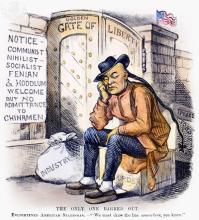In Autumn 2014 the Department of History will offer a new course in American history - HSTAA 110 American Citizenship. Designed and taught by Professor John M. Findlay, this course presents a clear, thematic focus on citizenship - an issue that is of enduring interest and importance today -- that supplements the department's introductory survey course in United States history. By examining how, when, and why different groups of people (e.g., white men, white men without property, peoples of color including one-time slaves, women, immigrants) became eligible for citizenship throughout American history, this course explores how and why for many peoples, at many times, citizenship did not confer equal rights to all.
"Citizenship is crucial because it defines the relationship of people to their nation. Focusing on the topic illuminates much U.S. history." -- Professor John M. Findlay
Professor Findlay explains that there are "both intellectual and pragmatic reasons for enrolling in HSTAA 110." Intellectually, the topic of citizenship is "crucial to how a nation defines itself and its members." To Findlay, the boundaries of the "nation" are defined by questions such as:
- Who gets to the be a citizen, and when? (For instance, when did white men without property, Black slaves, and Native Americans get to be citizens?)
- Which groups are assigned second-class citizenship, and why? (For instance, how is it that 19th-century white women were deemed citizens yet could not vote?)
- How do the nation's concepts of the benefits and responsibilities of citizenship change over time? (For instance, who could and could not serve in the armed forces, and how did service help some groups to gain fuller membership?)
- Americans have often viewed themselves as a "nation of immigrants": how did that self-perception correspond to the legalities of citizenship?
On a more personal level, this course will make U.S. history relevant to students living in the U.S. by engaging with readings that connect issues of citizenship with the experiences of American families. For one assignment, students will produce a research paper that allows them to assess the place of their family members within the nation's past.
More pragmatically, HSTAA 110 helps students to meet a number of requirements. It has been approved as a course that meets UW's diversity requirement for undergraduates. It also helps students meet the W (Writing) requirement. And in Autumn of 2014 HSTAA 110 will be taught with Writing Links, i.e. composition courses taught by the English Department that enable students to improve their writing by working on assignments related to the course content of HSTAA 110. Additionally, for students who have passed the AP U.S. History exam and therefore enter UW with credit for HSTAA 101, this course provides an attractive option for those students new to UW who want to get credit for some form of U.S. history that doesn't duplicate what they have achieved with their AP U.S. History credits.
HSTAA 110 is open to all undergraduates. However, it has been designed with the hope that many students in their first quarter at UW will benefit from taking it. The course will work on skills that will be valuable throughout one's college career--critical reading, conceptual thinking, effective researching, essay writing, and so on. On top of that, Professor Findlay hopes it will get students to look at the past and present of the United States in a new way.
As a way of providing extra support to students in their first year of university, Professor Findlay makes a point (in 100-level courses) to set aside 90 minutes every week for coffee with students who want to converse about anything--the UW, Seattle, the course materials, and so on. It is his aim to provide plenty of support, understanding that new students often endure periods of adjustment to life at UW.
Click here for a full list of upcoming undergraduate courses in the Department of History.
Chinese Exclusion Cartoon: This cartoon expresses opposition to the 1882 Chinese Exclusion Act. A key feature is the list of groups who are still eligible for admission to the US (e.g. Communists, Fenians, etc.) while the Chinese, associated with Industry, are excluded. (Source: Time)
